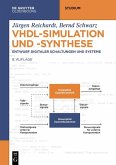Historically, VHDL is designed to describe logic ICs rather than defining them. However, VHDL is mostly used for "defining" rather than "describing" actually implemented logic ICs nowadays. The behavioural design approach becomes more important than classical gate level design approaches. The industry's necessity of speed in the design process of logic systems made it mandatory. It is easier and faster to leave the reduction of logic expressions to smart software systems. This book is written with this rule in mind. We preferred a behavioural approach in the design of logic systems. We used VHDL to define hardware in our examples rather than describing an already implemented integrated circuit in the gate level.
Despite we used a behavioural approach in the design of our examples in the book, usage of VHDL effectively necessitates a good understanding of gate level operation principles of logic circuits. So, the reader is expected to know a great deal about logic circuits. This book is planned as a supplement to logic circuit design courses at undergraduate level. However, anyone who knows something about logic circuits can also benefit from the book.
The book is also interesting in the regard that it makes an introduction to the subjects of artificial intelligence, neural networks and signal processing in the last two chapters. Especially, the reader will find interesting the "Nenet" example which utilizes "Neronaurallogix" cells (N-cells) in a network configuration. The Nenet resembles a RNN in most aspects.
All the chapters incorporate example designs which can be implemented on a cheap FPGA prototyping platform with minor modifications. The hardware target used in the examples is Digilent's CMOD-A7-35t FPGA module. However, any other FPGA platform can be used to implement the examples with minor modifications. The simulation and verification activities in the book is done mostly on software simulations. But as said before, the examples can be easily modified to implement in an actual real-world environment and the results are evaluated in lab settlement using a basic logic analyser.
The example VHDL design codes in the book are published in a Github repository where reader can download and observe them easily.
I hope that the reader finds this book useful in their quest to learning VHDL and its implementation on FPGA platforms.
Dieser Download kann aus rechtlichen Gründen nur mit Rechnungsadresse in A, B, CY, CZ, D, DK, EW, E, FIN, F, GR, H, IRL, I, LT, L, LR, M, NL, PL, P, R, S, SLO, SK ausgeliefert werden.









